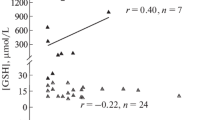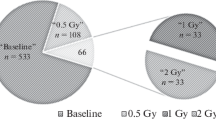Abstract
Clastogenic factors were first described in the plasma of people who had been accidentally or therapeutically irradiated. They were found also in A-bomb survivors, where they persisted for many years after the irradiation. The present study searched for these factors in the plasma of 32 civil workers from Armenia, who had been engaged as “liquidators” around the Chernobyl atomic power station in 1986. It also included 15 liquidators who had emigrated from the ex-Soviet Union to Israel. Reference plasma samples were obtained from 41 blood donors from the Armenian Blood Center in Yerevan. The samples were tested for their clastogenic activity in blood cultures from healthy donors. The majority of results from the liquidators exceeded those from the unexposed reference samples. The samples from the first Armenian group, with the higher average irradiation dose (0.6±0.6 Gy), were more clastogenic than those from the second group exposed to 0.2±0.2 Gy. The number of aberrations in the test cultures was 17.9±2.9% and 10.5±3.8% respectively, compared to 5.7±3.2% in the cultures exposed to the reference ultrafiltrates from Armenian blood donors. The samples from the Israeli liquidators also induced significantly increased aberration rates (14.0±3.9% aberrant cells). The clastogenic activity was regularly inhibited by superoxide dismutase, indicating that the chromosome-damaging effects of radiation-induced clastogenic factors are exerted via the intermediation of superoxide radicals, as is known for clastogenic factors of different origin.
Similar content being viewed by others
References
Auclair C, Gouyette A, Levy A, Emerit I (1990) Clastogenic inosine nucleotides as components of the chromosome breakage factor in scleroderma patients. Arch Biochem Biophys 278: 238–244
Emerit I (1990a) Clastogenic factors: detection and assay. Methods Enzymol 186: 555–564
Emerit I (1990b) Superoxide production by clastogenic factors. In: Crastes de Paulet et al. (eds.) Free radicals, lipoproteins and membrane lipids. Plenum Press, New York, pp 99–104
Emerit I (1994) Reactive oxygen species, chromosome mutation and cancer. Possible role of clastogenic factors in carcinogenesis. Free Radical Biol Med 16: 99–109
Emerit I, Cerutti P (1982) Tumor promoter phorbol-myristate acetate induces a clastogenic factor in human lymphocytes. Proc Natl Acad Sci USA 79: 7509–7513
Emerit I, Lahoud-Maghani M (1989) Mutagenic effects of TPA-induced clastogenic factor in Chinese hamster cells. Mutat Res 214: 97–104
Emerit I, Khan SH, Cerutti P (1985) Treatment of lymphocyte cultures with a hypoxanthine-xanthine oxidase system induces the formation of transferable clastogenic material. Free Radical Biol Med 1: 51–57
Emerit I, Khan SH, Esterbauer H (1991) Hydroxynonenal, a component of clastogenic factors? Free Radical Biol Med 10: 371–377
Faguet GB, Reichard SM, welter DA (1984) Radition-induced clastogenic plasma factors. Cancer Genet Cytogenet 12: 73–83
German J (1972) Genes which increase chromosomal instability in somatic cells and predispose to cancer. In: Steinberg AG, Bearn AG (eds) Progress in medical genetics. Grune & Stratton, New York, pp 61–101
Goh KO (1975) Total body irradiation and human chromosomes. V. Additional evidence of a transferable substance in the plasma of irradiated persons to induce chromosomal breakages. J Med 6: 51–60
Goh KO, Sumner H (1968) Breaks in normal chromosomes: are they induced by a transferable substance in the plasma of persons exposed to total body irradiation? Radiat Res 35: 171–181
Hollowell JG, Littlefield LG (1968) Chromosome damage induced by plasma from irradiated patients. An indirect effect of X-ray. Proc Soc Exp Biol Med 129: 240–244
Kohen R, Tirosh O, Gorodetsky R (1992) The biological reductive capacity of tissues is decreased following exposure to oxidative stress: a cyclic voltammetry study of irradiated rats. Free Radical Res Commun 17: 239–248
Linet MS, Boice JD (1993) Radiation from Chernobyl and risk of childhood leukemia. Eur J Cancer 29A: 1–3
Neriishi K (1991) Possible involvement of free radical mechanism in late effects of A-bomb (abstract). 5th International Congress on Oxygen Radicals, Kyoto, November 1991 pp 1103–1104
Neriishi K (1992) Oxidative stress in atomic bomb survivors (abstract). Free Radical Res Commun 16 [suppl 1] p 34
Pant GS, Kamada N (1977) Chromosome aberrations in normal leukocytes induced by the plasma of exposed individuals. Hiroshima J Med Sci 26: 149–154
Scott D (1969) The effect of irradiated plasma on normal human chromosomes and its relevance to the long-lived lymphocyte hypothesis. Cell Tissue Kinet 2: 295–305
Souto J (1962) Tumor development in the rat induced by blood of irradiated animals. Nature 195: 1317–1318
Author information
Authors and Affiliations
Rights and permissions
About this article
Cite this article
Emerit, I., Levy, A., Cernjavski, L. et al. Transferable clastogenic activity in plasma from persons exposed as salvage personnel of the Chernobyl reactor. J Cancer Res Clin Oncol 120, 558–561 (1994). https://doi.org/10.1007/BF01221035
Received:
Accepted:
Issue Date:
DOI: https://doi.org/10.1007/BF01221035




